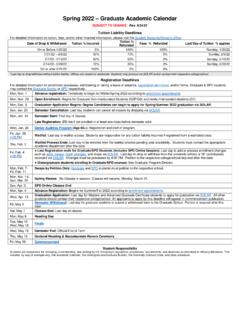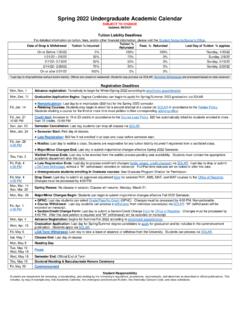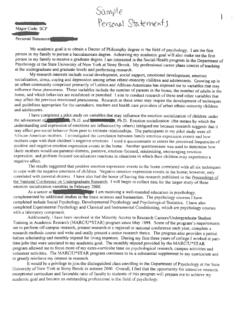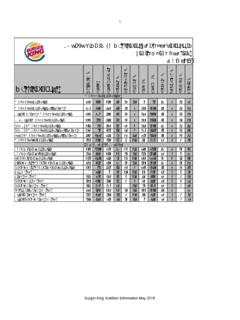Transcription of The Dangers of Eating Fast Food - Stony Brook …
1 THE HEART LINKS PROJECTA MEMBER OF THE NYS HEALTHY HEART COALITIONThe Dangers of Eating fast FoodIn a society that functions at a high speed, fast food has quickly been adopted as the preferredfood of choice. fast food restaurants and their advertisements are permeating ourneighborhoods, schools, television, and culture. burger king and Big Mac burgers have becomedefining foods of the typical American diet. Corporate goals aim to make these chains moregeographically accessible, adding more and more chains to our neighborhood s and burger king are not the only fast food industries invading our communities, ourminds, and our stomachs; Taco Bell, Pizza Hut, Kentucky Fried Chicken are just a few industries are successful because they offer consumers a quick, cheap, convenient andtasty meal that is all too often high in fat and salt content and low in fiber and calcium.
2 Creativemarketing strategies that offer super-value meals or super-size perks result in further promotionof these industries. Unhealthy processed foods such as these are a potential health threat sincethey contribute to the increased prevalence of obesity and chronic disease among is becoming the largest public health concern as we enter the new millenium,especially among children. Obesity increases the risk for high cholesterol and fatty streakdevelopment, which translates into greater risk for cardiovascular disease. One meal at a fastfood restaurant may contribute a significant amount of fat and sodium for the day.
3 For example,McDonald s new Spanish omelet bagel contains 710 calories, 40 grams of fat, 275 mg ofcholesterol and 1,520 mg of sodium. High fat diets and bigger portions in combination withdecreased physical activity play major roles in the obesity epidemic. Technology has itsdrawbacks since fewer children are playing basketball and the majority of them surf the net instead. Children consuming diets high in fat often displace nutrient dense foods such as wholegrains, fruits and vegetables. Diets high in fat are also typically low in fiber because of the lackof complex carbohydrates.
4 Complex carbohydrates are often high in fiber, which is associatedwith lower cholesterol levels, improved digestive function, and decreased risk of cardiovasculardisease and some forms of cancer. Some studies have shown that increasing dietary fiber amongchildren may be preventative in the development of childhood obesity. Unfortunately fast foodsare more palatable, more filling and more caloric per bite, resulting in greater demand andincreased consumption. fast food also has many social implications, often acceptable in peerenvironments or associated as rewards or celebratory high salt content of fast foods also pose many threats to the health of Americans, youngand old.
5 Salt consumption is associated with high blood pressure, strokes, and kidney addition, some studies have shown that calcium competes with sodium. In other words, as theintake of sodium increases, there is an increase in the urinary excretion of calcium. Thisincreased excretion of calcium may be responsible for reduced peak bone mass and increasedbone demineralization which, in turn, increases the risk for osteoporosis and bone fracturesamong women. This concept is extremely important when thinking in terms of children who arein the critical stage of developing bone recommended limit for sodium is 2,200 mg.
6 On average, however, women consume3,200 mg per day. Exceeding these recommendations is often easy since a burger KingWhopper contains 870 mg of sodium and a large order of McDonald s fries contains 290 mg,making it possible for individuals to reach more than half the limit in one meal. On the otherhand, the RDA for calcium is 800 mg per day but the average intake among women is less than600 mg. This information illustrates the need for healthy food alternatives. Incorporatingnutrient dense food choices and healthy snacks into an active lifestyle may help improve healthof the general population and prevent the onset of is apparent that fast foods are always a temptation because they are widely available,convenient and cheap, but as parents and educators it is important to set examples for children toemulate.
7 Parents and educators can be more involved in increasing awareness regarding thenegative effects of fast foods and discourage children from consuming them. Since many foodpatterns begin during childhood, parents and teachers should avoid using fast foods as rewardingmeals and attempt to educate children on healthy food choices. Super-sizing meals to get morefor your dollar may contribute to unnecessary calories and fat. Encouraging the consumption ofa balanced diet, high in complex carbohydrates such as legumes, fruits, vegetables, and wholegrains may result in many health benefits.
8 In addition, promoting a diet rich in calcium, which isfound in dairy sources such as low-fat milk and cheese or in other sources such as broccoli orkale promotes peak bone mass and decreased risk for osteoporosis and bone fractures later inlife. In general, a diet low in fat, especially saturated fat, low in salt and high in fiber andcalcium can prevent obesity and disease. Advocating nutrient dense diets, rich in whole grains,fresh fruits, and vegetables and increased physical activity may serve as the greatest investmentof society, the health of our and teachers can educate and empower children by involving them in creatingsimple, fun, and creative homemade alternatives.
9 Teaching children skills such as gratingcheese, washing and cutting vegetables, may make them more apt to preparing meals themselves,and less likely to purchase fast foods. Some ideas are baked potatoes, which are a good sourceof potassium, iron and vitamin C. They can be topped with low-fat sour cream, reduced fatcheese and steamed vegetables such as broccoli. Another idea is homemade pizza made withpita bread, tomato sauce, grated low fat cheese, and fresh vegetables. Other ideas are turkeyburgers made with lettuce, low fat cheese and mayonnaise or burritos made with baked beans,low-fat cheese, and vegetables.
10 The ultimate message is that nutritious meals can be fun and canbe incorporated into everyday life. Showing children how to prepare low fat snacks and mealsmay deter them from developing unhealthy Eating patterns and prevent the onset of obesity T, MacGregor GA. Salt-more adverse effects. Lancet 1996;347 LL, Fisher JO. Development of Eating behaviors among children and 1998;101 K, Liebman B. The pressure to eat: why we re getting fatter. Nutrition ActionHealthletter 1998;25 L, Hurley J. Meals to go. Nutrition Action Healthletter 1998;25 K, Basil M, Maibach E, Goldberg J, Snyder D.













